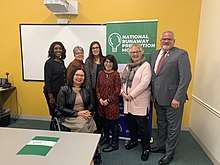National Runaway Safeline
The National Runaway Safeline (also known as NRS or 1-800-RUNAWAY; formerly known as National Runaway Switchboard) is the national communications system designated by the United States federal government for runaway and homeless youth, their parents and families, teens in crisis, and others who might benefit from its services. It is confidential, anonymous, non-judgmental, non-directive, and free. The hotline number is 1-800-RUNAWAY. Calls are answered every day of the year, 24 hours a day.[1][2]
| Founded | 1971 |
|---|---|
| Type | 24-hour federally designated national communications system |
| Focus | The National Runaway Safeline provides education and solution-focused interventions, offers non-sectarian, non-judgmental support, respects confidentiality, collaborates with volunteers, and responds to at-risk youth and their families 24 hours a day. |
| Location |
|
Area served | United States and territories, including Puerto Rico, the U.S. Virgin Islands, and Guam |
| Method | free 24-hour services, expertise in all youth-related issues and as an information clearinghouse of youth services. |
Executive Director | Maureen Blaha |
Employees | 25 |
Volunteers | 150+ |
| Website | 1800RUNAWAY.org |

NRS answers well over 100,000 calls a year from all states and U.S. territories. In 2008, forty-nine percent of the crisis calls were from youth. Half of the youths making crisis calls were on the street. Some of the problems identified by callers to 1-800-RUNAWAY include: family dynamics, peer and social problems, school education, physical abuse, and alcohol or drug use. Some simply wish to talk and need an attentive listener. They can also obtain referrals to legal resources in their community and employment programs. NRS maintains a database of over 16,000 organizations throughout the country to which callers can be referred, and other specialized hotlines that serve youth and families.
Parents or other relatives of runaways also frequently turn to the hotline to find help in learning what they can do about a child who has run away, how to go about making an official report, and to get emotional support during the crisis. Often, parents call not because their children already are missing, but because they fear they might run away in the future or because of ongoing problems involving discipline, drug abuse or alcohol abuse, truancy, etc.
Runaways can use the NRS message service to forward messages to parents or guardians after they have run away, if they do not wish to call them directly. Parents or guardians can, in turn, leave messages with the NRS for a youth who has run away to pick up. The hope is that these relays will form a foundation for improved communication between the runaway and the family and make reunification more likely. NRS also can make conference calls to connect runaways with their family members if they do wish to call them but don't have money for the call, or if they wish an NRS to moderate the conversation and help to smooth the discussion.
NRS, in conjunction with Greyhound Lines, administers the Home Free program, which has reunited more than 13,000 runaway youth with their families with free bus tickets back home.
NRS also maintains a website, www.1800RUNAWAY.org, which was significantly revamped in 2006 and which presents a wide range of information on NRS and on runaway and homeless youth in general, including guidance for what families should do if a child is missing.
The switchboard calls are answered both by staff members and volunteers. The organization has more than 150 volunteers, all of whom are based in the NRS office in Chicago. Volunteers receive 40 hours of training before they can start to work on the crisis line, and are closely supervised by paid NRS staff.
The organization is financed by federal and state agencies, personal donations, and grants from private companies and charitable foundations.
The agency also has developed, in cooperation with DePaul University, an extensive Runaway Prevention Curriculum for use by community organizations and educators. It is available either through Internet download or as a CD-ROM. The organization also can supply schools and other organizations with promotional materials, such as posters and pamphlets, that highlight issues relating to teen runaways.
From 2000-2018, the agency was directed by Maureen Blaha, a former head of a statewide child abuse program for the Children's Home and Aid Society of Illinois. Blaha also used to be the executive liaison for the Massachusetts Office for Children, an advocacy and regulatory agency.
The current Executive Director is Susan Frankel, a former Board member and inspiring leader.
In 2006, Ludacris (singer Chris "Ludacris" Bridges) featured The National Runaway Switchboard in the music video of his Grammy-award winning single, "Runaway Love".
The history of NRS goes back to the early 1970s. In 1971, Metro-Help was established to help Chicago youth in crisis as a clearinghouse to connect them with services throughout the region. In 1974, the crisis line received an 8-month demonstration grant from the federal government to expand its scope from a local line to a national call center and a short time later changed its name to National Runaway Switchboard. NRS was officially designated by the government as the country's "national communication system" to assist runaway youth and homeless teens. NRS is the oldest such hotline in the world, and has received over 3 million calls since its founding.
References
- Bostedt, Shelbie Lynn (August 9, 2017). "Do good this week with the National Runaway Safeline". RedEye. Chicago Tribune. Retrieved 10 April 2018.
- DeWitt, Kaylee (March 26, 2018). "A day in the life of a crisis hotline volunteer". Deseret News. Retrieved April 10, 2018.